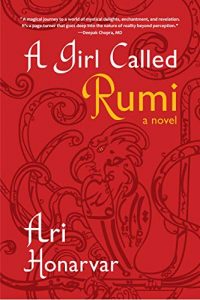Maya C. James Reviews A Girl Called Rumi by Ari Honarvar
 A Girl Called Rumi, Ari Honarvar (Forest Avenue Press 978-1-942436-46-1, $16.00, 362pp, tp) September 2021. Cover by Ari Honarvar.
A Girl Called Rumi, Ari Honarvar (Forest Avenue Press 978-1-942436-46-1, $16.00, 362pp, tp) September 2021. Cover by Ari Honarvar.
Content warning: self-harm.
Ari Honarvar’s debut novel, A Girl Called Rumi, is a sage, beautifully-written fantasy novel. Against the intense backdrop of the Iran-Iraq war and eventual Green Uprising, Kimia uses storytelling to escape, and discovers a storyteller that will lead her through the Seven Valleys of Love – an intense quest that she leaves unfinished before fleeing to America. Only years later will she complete her quest, this time with her brother’s life at stake should she fail. At the end of this journey is the Simorgh, a mystical, powerful bird that lies at the end of the Seven Valleys.
Set in a series of flashbacks and present-day narration, Kimia rediscovers her deeply buried childhood after colliding with a large, mysterious bird in her mother’s California garage. Long-subdued memories surface as she recounts her adventures with Baba Morshed, a mystical storyteller that led her through the Seven Valleys of Love. We witness Kimia’s journey through the valleys as she visits Baba Morshed’s home under a stage to listen to stories. Fearful of the morality police, she tells Baba Morshed that her name is Rumi, after Jalāl ad-Dīn Mohammad Rūmī, her mother’s favorite poet.
Told from multiple perspectives, we learn of Kimia’s complicated and loving family. Roya: her temperamental mother who recites poetry even with her declining health. Arman, her protective brother turned nightclub owner, and her father, a man whose unyielding love is felt only at a distance due to his mysterious line of work. Though the novel is not in verse, it contains a welcome number of verses, and appears to be heavily influenced by Sufi poet Fair dud-Din Attar’s, or Attar of Nishapur’s, The Conference of the Birds. In this tale, told by Baba Morshed over the course of A Girl Called Rumi, birds of various sizes and personalities attempt to declare a ruler: they decide to cross the Seven Valleys until they reach the Simorgh, a legendary bird. The experiences of these birds are reflected in each chapter – each valley contains its own realizations, some harder than others. Kimia encounters this journey not just through Baba Morshed’s storytelling, but through her own life.
Now living in San Diego as a life coach, Kimia struggles to cope with her not-so-distant memories of Shiraz, and the complex emotions they carry. Worst, with returning to Shiraz knowing she has not completed her journey through the Valley of Death – the seventh and final valley before reaching the Simorgh.
Honarvar’s seamless blend of Sufi poetry and Kimia’s life experiences elevate the reading experience from an enjoyable one to a sensory one, where the reader feels as swept up in the stories as Kimia does. That experience, combined with Kimia’s complicated family relationships, made this a layered, complex reading.
Despite being a life coach in California, Kimia, like most of us, has some unhealthy coping mechanisms from an unhealthy childhood. Honarvar makes family more complex. Roya, Kimia’s mother, is not necessarily the best mother, but she’s far from a villain in this story. She’s simply a complex character whose flaws impacted her children. In an ultimate act of love and sacrifice, Kimia returns to Shiraz due to her mother’s failing health, and uncovers additional secrets from her childhood.
Hornavar is able to make even the smallest of moments into an epic tale: her pacing and other technical details are subtle and well-delivered. The footnotes that Hornavar adds for translation purposes help to preserve the pace of the book. Glossaries often interrupt the flow of reading for those of us that need them. The front cover, too, is designed by Honarvar. The imagery of the Simorgh spells out verse in Farsi: “Attar explored the Seven Valles of Love/ We are still getting around one corner.” Honarvar undertook all of these translations herself. A dancer calligram in the space breaks spells out a verse from Rumi’s Gift: “Even if the sky/ poison befalls all/ I’m still sweetness/ wrapped in sweetness/ wrapped in sweetness/ wrapped in sweetness.”
I also enjoyed many of the characters in the novel. Kimia, Arman, and Roya captured my heart within moments of picking up the book. Kimia, with her rebellious nature and Bruce Lee T-shirt, was limitless in her imagination. Arman was stoic yet unselfish in his care for others. And Roya, their ailing mother that seemingly only speaks in poetry and rage, became an unlikely redemptive figure by the book’s end. While the violence of the novel, and the backdrop of weapons sales and Western influence is not lost on me, the characters are more than just hollow, war-ravaged backdrops for a larger moral point; they’ve carved out their own futures and brought hope to others along the way.
A Girl Called Rumi is a precious gift; one infused with Ari Honarvar’s experiences and brilliant writing, translation, and drawing skills. What better word to describe a book carefully wrapped in the author’s own artwork than as a gift? Or, as Kimia’s mother’s name means: a dream.
Maya C. James is a graduate of the Lannan Fellows Program at Georgetown University, and full-time student at Harvard Divinity School. Her work has appeared in Star*Line, Strange Horizons, FIYAH, Soar: For Harriet, and Georgetown University’s Berkley Center Blog, among others. She was recently long listed for the Stockholm Writers Festival First Pages Prize (2019), and featured on a feminist speculative poetry panel at the 2019 CD Wright Women Writer’s Conference. Her work focuses primarily on Afrofuturism, and imagining sustainable futures for at-risk communities. You can find more of her work here, and follow her on Twitter: @mayawritesgood.
This review and more like it in the December 2021 issue of Locus.
 While you are here, please take a moment to support Locus with a one-time or recurring donation. We rely on reader donations to keep the magazine and site going, and would like to keep the site paywall free, but WE NEED YOUR FINANCIAL SUPPORT to continue quality coverage of the science fiction and fantasy field.
While you are here, please take a moment to support Locus with a one-time or recurring donation. We rely on reader donations to keep the magazine and site going, and would like to keep the site paywall free, but WE NEED YOUR FINANCIAL SUPPORT to continue quality coverage of the science fiction and fantasy field.
©Locus Magazine. Copyrighted material may not be republished without permission of LSFF.





